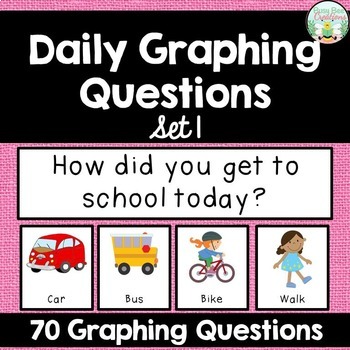Daily Graphing Questions - Set 1
- Zip
What educators are saying
Also included in
- Save money by buying the bundle!! You get set 1, set 2. and set 3 for a total of 195 questions! Use one for everyday of the school year!Making data collection part of your daily routine is easy with these 195 graphing cards. Students will take a genuine interest because they will get to cast theirPrice $17.50Original Price $21.00Save $3.50
Description
Making data collection part of your daily routine is easy with these 70 graphing cards. Students will take a genuine interest because they will get to cast their vote on a regular basis to a variety of kid friendly questions. Each survey question comes with 2-4 picture choices making it easy for you to differentiate according to the needs of your students.
The graphing questions and choices are designed to fit in a rectangular pocket chart (approximately 12 x 30 – chart not included), but could also be displayed just as easily on a board using magnetic tape. The students cast their vote by placing a small colored rectangle above their choice. Check out the picture in the preview to see exactly what I mean.
Choose a question from the 70 different graphing questions included. Display the question and choices either on the board or in a pocket chart. Each day, choose 5-10 students to cast their votes and then interpret the results as a class. Because new students get to cast their votes each day, the graph is constantly changing and can be reinterpreted everyday. To create the opportunity for higher level questioning, have your boys cast their vote using a different color than the girls. Once everyone has had a chance to vote, it’s time to choose a new question!
I have also included a printable graphing worksheet that can be used in conjunction with these cards. The worksheet is designed to be used with any of the graphing questions and requires that the students use the data collected by their classmates to create a tally chart, a bar graph, a picture graph and then finally to use their math thinking to write about their graphs and the data that was collected. This is a great way to occasionally assess the students' understanding.
Some of the graphing questions included are:
How did you get to school today?
Which color do you like most?
What is your favorite season?
Did you buy or pack your lunch today?
Which hot weather activity is your favorite?
Which ice cream flavor is your favorite?
Do you have siblings?
What is your favorite thing to do in the rain?
Can you roller skate?
Which animal makes the best pet? (x2)
Have you ever flown on an airplane?
Have you ever been camping?
Which indoor activity do you like best?
Which school subject is your favorite?
Which sport is your favorite?
Have you ever been on a cruise?
Which drink do you like most?
Which dessert do you like most?
Which musical instrument do you like best?
Which vegetable do you like best?
Which dairy product do you like most?
How did you feel on the first day of school?
Which snack food do you like most?
Have you ever been to the circus?
Which insect do you like most?
Which kind of candy do you like most?
Do you know how to swim?
What color is your hair?
Which fruit do you like best?
Which pizza topping do you like most?
Which type of weather do you like most?
Can you whistle?
Plus many more! 70 Questions Total!
To see the DIGITAL GOOGLE SLIDES version of this product, click here!
I have also included a blank template so that you can create your own questions!
Please download the preview so you can get a closer look!
To see my Daily Graphing Questions - Set 2 click, here
To see my Daily Graphing Questions - Set 3, click here.
To see my Daily Graphing Questions Bundle (containing sets 1, 2, and 3) click here.
Do your students speak Spanish? Check out the Spanish versions by clicking on the links below.
Do you need UK English spellings? Click on the links below.
Thanks for looking!
************************************************************************************************************************************************
It pays to become a follower! All new resources are discounted 50% off for the first 48 hours. Just look for the green start at the top of the page next to my store logo and click on it to become a follower. When you do this you will receive email updates and information about upcoming sales and new products!
Have Questions? If you have any questions about this product, please feel free to send me an email at abusybeecreations@gmail.com. I am always happy to help!
Want to see more? Follow me on Pinterest!
© Busy Bee Creations – This product is intended for single classroom and personal use only.






